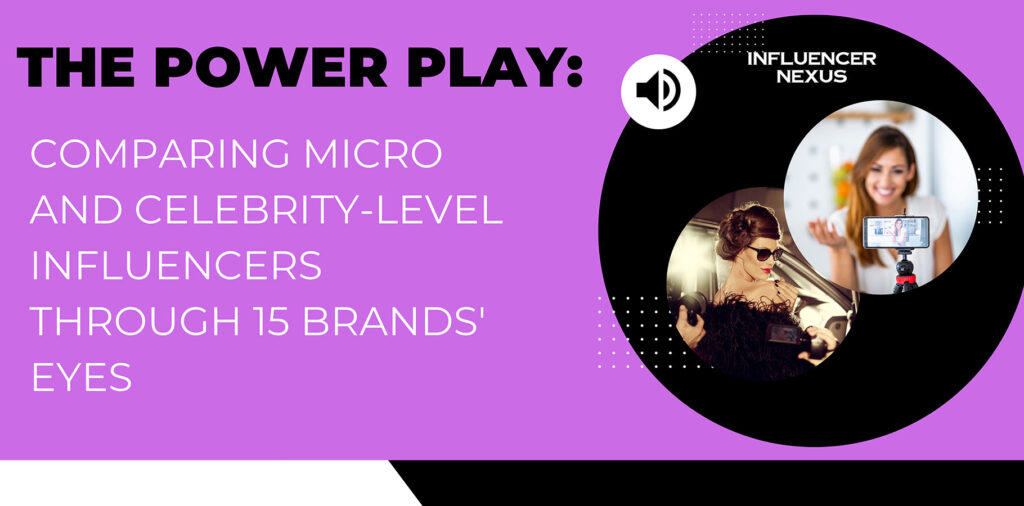The Power Play: Comparing Micro and Celebrity-Level Influencers Through 15 Brands' Eyes
We conducted a survey to uncover insights from marketing executives at medium and large-sized brands who have executed influencer marketing campaigns with both micro and macro-level influencers
Here, we’ve summarized the takeaways on the following:
- Comparing outcomes achieved with micro-influencers to those with macro or celebrity influencers
- Authenticity with micro-influencers vs. macro-influencers
- 4 expert recommendations for crafting a winning influencer program
Comparing outcomes achieved with micro-influencers to those with macro or celebrity influencers
Here are our findings:
- The majority of brands had the highest results with micro-influencers (80%)
- A few brands believed that a combination of micro and celebrity influencers was the most potent strategy (20%)
- Zero brands believed that a celebrity-level influencer strategy alone was the most effective

Don Barnett, Director of Sales & Marketing at LondonHouse Chicago, believes that the engagement and loyalty factor is much higher with micro-influencers:
For many brands, the other factor to consider is cost per client acquisition. Obviously, if the influencer is at a celebrity-level status, their cost per post will be significantly higher, and thus require a higher acquisition number to justify the cost.
David Klein, Co – Founder of Orange Line Digital explains it like this:
On the other hand, Adam Rossowof, Co-Founder at Grouprfz believes that celebrity-level influencers can be incredibly beneficial too:
Both celebrity-level and micro-influencers have their distinct benefits. And while celebrity influencers indefinitely ‘beat’ micro-influencers when it comes to recall/memory, micro-influencers seem to have equal power in purchasing decisions.
The combination of influencers your brand chooses is completely dependent on your outcome goal.
Authenticity with micro-influencers vs. macro-influencers
100% of executives believed that followers perceive content from micro-influencers as more authentic than that from macro or celebrity influencers:

When we asked our contributors to explain some context behind their answers, we found varying experiences across the board.
According to Elliot Brown, Head of Marketing for Cashe, believes that micro-influencers have a deeper trust factor with their audience:
All the brand executives interviewed unanimously agreed that micro-influencers are also substantially better at reaching niche audiences than celebrity-level influencers.
See here:

Because micro-influencers typically attract audiences for a very specific topic –be it fashion, fitness, beauty, and so on– it’s very easy for brands to find influencers whose audience is made up of 80% or more people deeply interested in the product they sell.
For example, a quality fashion micro-influencer with 10,000 followers will have a large majority of their audience also interested in fashion.
However, celebrity-level influencers don’t function the same.
While their followers may admire them for various reasons, they may not always exhibit a heightened interest in a particular category.
This poses a challenge for brands aiming to pinpoint laser-targeted demographics solely through the use of celebrity-level influencers.
5 Expert Recommendations For Crafting a Winning Influencer Program
1. Select the Influencer Tier Based on Your Desired Outcome
The brands that believed celebrity influencers and micro-influencers should be chosen equally also outlined the distinct benefits of both.
Choosing the caliber of influencers based on resources available and outcome goals was a key recommendation.
Kait Shiels, Founder of Spark Social Agency shared her thoughts:
2. Micro-influencers may have a higher immediate impact on purchasing decisions
While many contributors have mentioned the significance of authenticity and trust with micro-influencers, it’s also important to note that micro-influencers have the capability of directly engaging with their audience far more than celebrity-level influencers.
By default, a smaller following means less engagement most of the time. However, the engagement that does occur between micro-influencers and their audience is deeply meaningful.
Micro-influencers with a strong impact tend to respond to all (or nearly all) of their comments. They also have the capability to answer many of their audience’s questions during Q&As.
Celebrity influencers, however, almost never answer all comments because they typically have hundreds of comments per post, and their Q&As receive hundreds or thousands of questions that cannot all be responded to within the 24-hour time allotted by platforms like Instagram.
This is advantageous for micro-influencers because it allows them to form a strong bond, often individually, with differing audience members.
This bond deepens their influence and can strengthen their immediate impact on their audience’s purchasing decisions after promoting a product.
Dmitriy Bobriakov, Marketing Director of Buzz.Biter, made a point to hit this home:
3. Celebrity Influencers are the go-to for “spreading the word”
Bobriakov provided an incredible analogy to explain the impact of celebrity influencers:
“Working with macro influencers felt like the big concert. Imagine a famous musician wearing a t-shirt with our garden project logo during a performance. It’s super exciting, gets a lot of cheers, and tons of people see it. Our website might get a flood of visits, which is great! But not many come ready to plant tomatoes. The connection isn’t as personal, but it sure can make waves.”
And while celebrity-level influencers’ audiences don’t “come ready to plant tomatoes” right away in some cases, they do create the initial awareness of product/service existence at scale.
This enables brands to leverage landing page visits effectively across various marketing channels to engage and nurture these audiences.
For instance, individuals who have visited a landing page or clicked the “add to cart” button but haven’t completed their purchase can be efficiently retargeted and nurtured through paid ads on the same social media platforms where they have already demonstrated activity by engaging with promotions from celebrity influencers.
4. Avoid hasty scaling in influencer marketing
If your brand hasn’t yet dabbled into influencer marketing or is in the beginning stages of building this strategy as a new marketing channel, many of the experts suggested scaling without rushing the process.
Rossowof explained his rationale for avoiding hasty scaling with influencers:
Since almost every marketing strategy requires some form of ‘ironing out the kinks’ and applying different methodologies after testing, reporting, and analytics, it would likely save both time and investment to learn at a smaller scale, and then apply the learnings at a large scale.
What’s Next?
Despite the many recommendations for crafting a winning influencer model within your brand, all of the executives re-iterated some variation of the four above.
Here are some closing words from Barnett:
Ultimately, different calibers of influencers offer distinct benefits. And while micro-influencers might be favored in some categories, macro and celebrity-level influencers will be favored in others.
The idea is to understand where each type shines and collaborate with them accordingly.
And if:
- All of this sounds like too big of a learning curve or,
- You want to offload the work to a reputable agency that helps brands scale with influencer marketing
Then consider working with an influencer agency that:
- Is the first-ever influencer agency made up of both influencers and marketers
- Doesn’t focus on the ‘Tinder of Influencer Marketing’ or one-time brand deals that only garner short-term wins
- Integrates influencer marketing into every step of your brands marketing strategy
By booking a bro-bono influencer marketing strategy call here
















